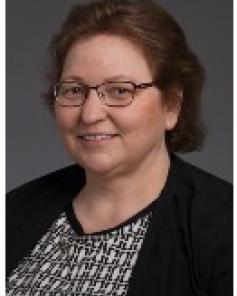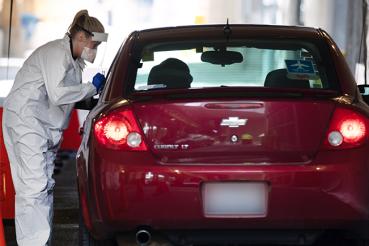In April, Margarita Garcia started feeling unusually tired and achy and began to have trouble breathing. She tested positive for COVID-19, and on a sunny spring day, she was admitted to the hospital.
She was discharged on a winter morning nine months later.
“I really thought I was going to spend a little time here, maybe a couple of weeks,” Garcia, who speaks Spanish, says through an interpreter.
Initially admitted to a hospital near her home on April 21, she was transferred to Rush University Medical Center four days later to treat her severe respiratory symptoms and lack of oxygen in her blood. She ended up spending an astonishing 261 days — two-thirds of the year — in Rush’s intensive care unit fighting for her life.
Lifesaving life support
Only a few days after arriving at Rush, Garcia was placed on ECMO, short for extracorporeal membrane oxygenation, which uses a machine to add oxygen to the blood and remove carbon dioxide before pumping it back into circulation.
Managed by a specialized team of nurses, physicians, respiratory therapists and clinical staff, ECMO is a type of life support system that is used to help critically ill COVID patients for whom ventilators and other treatments aren’t enough.
Rush is a Gold-Level Center of Excellence in Life Support for both adult and pediatric ECMO patients. The Rush ECMO team does about 50 of these procedures every year for patients with severe heart and/or lung conditions, usually only after attempting every other appropriate intervention. Like Garcia, most ECMO patients would almost certainly die without it.
“She came to us with severe lung disease after having severe COVID, and we were able to support her lungs for eight months,” says Nitesh Mody, DO, a cardiothoracic anesthesiologist and critical care specialist. “She had a few bumps in the road, but she’s a fighter, so she was able to get through.”
In fact, Garcia spent the longest time on ECMO of any Rush COVID-19 patient and had the second longest COVID-19 stay. “I am alive, and I was able to come back,” she says.
ECMO team by her side
In addition to the ECMO treatment that did the work for her lungs, Garcia credits her recovery to the team, including heart surgeon Deborah Tabachnick, MD, the ICU physicians, nurses and staff who cared for her.
“Every single member of the team on this unit was very kind to me,” she says, adding they never let her feel like she was alone in her fight to survive.
In fact, the staff was with her every minute, through the ups and downs as her battle stretched through the spring, summer, fall and into winter.
With visitors strictly limited because of COVID-19, and with a machine pumping her blood, the people who cared for Garcia for so many months became very special to her, and she to them. She was with them for every holiday and even her 45th birthday, which they helped her celebrate.
“The nurses and therapists put up decorations in my room and brought me presents and a cake,” Garcia says.
Next steps bring joy
Finally, in early January, Garcia moved out of the ICU and into the acute rehabilitation unit to prepare to go home.
Before she left, however, she wanted to visit and thank the many people who cared for her 24 hours a day, 7 days a week for more than eight months.
When the employees in the ICU heard that Garcia would be stopping by the day before heading home, they put together a surprise celebration, with balloons, flowers, food and gifts. And on Jan. 22, more than two dozen employees lined the hallway to wish Garcia well, giving her a chance to express her gratitude for helping her reach each milestone — from sitting up to standing and to walking; keeping her connected with her children with video chats; and boosting her spirit as she watched other patients come and go while she remained in the unit.
Kevin Rice, RN, worked closely with Garcia to help her build her strength by prodding her to walk, even searching for music on his phone that would help her to keep going.
“Kevin was a very good therapist. He would help me with my walks, especially when I was starting to take my first steps,” Garcia says.
Jessie Soto of environmental services would chat with Garcia, offering support and sharing stories.
“Jessie is a very kind person. She would see me every morning, and she would say, ‘Margarita, you need to eat so you can have energy.’ ”
Soto enjoyed the chance to help. “I knew how lonely she sometimes was because she spoke only Spanish,” she says.
A successful fight for her life
Garcia’s long battle included some loneliness and worries, but the hardest part was being away from her four children, who range in age from 14 to 23.
“My family was my main motivation,” she says. “I wanted to live for them.”
In fact, asked during her goodbye celebration what she most looked forward to doing after leaving the hospital, she said she had only one wish:
“I want to get home to be with my family.”
Wearing a Rush T-shirt with the phrase “Getting Better Every Day” printed on the back, Garcia stepped out of her wheelchair for a final walk around the unit. It was another joyous moment for the team who worked so hard to help her return home.
“I get to see patients start off where she started off and help them progress to the point where now I get to see her go home,” Rice says. “That is extremely fulfilling.”
Mody adds: “A day like this is a celebration of life — for Margarita as well as the team.”





